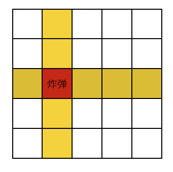在一个 n×m 的方格地图上,某些方格上放置着炸弹。手动引爆一个炸弹以后,炸弹会把炸弹所在的行和列上的所有炸弹引爆,被引爆的炸弹又能引爆其他炸弹,这样连锁下去。

现在为了引爆地图上的所有炸弹,需要手动引爆其中一些炸弹,为了把危险程度降到最低,请算出最少手动引爆多少个炸弹可以把地图上的所有炸弹引爆。
输入格式
第一行输两个整数 n,m,用空格隔开。
接下来 n 行,每行输入一个长度为 m 的字符串,表示地图信息。0表示没有炸弹,1表示炸弹。
数据约定:
对于 60% 的数据:1≤n,m≤100;
对于 100% 的数据:1≤n,m≤1000;
数据量比较大,不建议用cin输入。
输出格式
输出一个整数,表示最少需要手动引爆的炸弹数。
样例输入
5 5 00010 00010 01001 10001 01000
样例输出
2
方法一(DFS):

1 #include <stdio.h> 2 #include <string.h> 3 #include <iostream> 4 #include <string> 5 #include <math.h> 6 #include <algorithm> 7 #include <vector> 8 #include <stack> 9 #include <queue> 10 #include <set> 11 #include <map> 12 #include <sstream> 13 const int INF=0x3f3f3f3f; 14 typedef long long LL; 15 const int mod=1e9+7; 16 const double PI = acos(-1); 17 const double eps =1e-8; 18 #define Bug cout<<"---------------------"<<endl 19 const int maxn=1e5+10; 20 using namespace std; 21 22 char G[1005][1005]; 23 int n,m,ans; 24 int vx[1005],vy[1005];//vx[i]表示第i行有没有引爆过,vy[i]表示第i列有没有引爆过 25 26 void DFS(int x,int y) 27 { 28 G[x][y]='0'; 29 if(!vx[x]) 30 { 31 vx[x]=1; 32 for(int i=1;i<=m;i++) 33 { 34 if(G[x][i]=='1') 35 DFS(x,i); 36 } 37 } 38 if(!vy[y]) 39 { 40 vy[y]=1; 41 for(int i=1;i<=n;i++) 42 { 43 if(G[i][y]=='1') 44 DFS(i,y); 45 } 46 } 47 } 48 49 int main() 50 { 51 #ifdef DEBUG 52 freopen("sample.txt","r",stdin); 53 #endif 54 ios_base::sync_with_stdio(false); 55 cin.tie(NULL); 56 57 scanf("%d %d",&n,&m); 58 for(int i=1;i<=n;i++) 59 scanf("%s",G[i]); 60 for(int i=1;i<=n;i++) 61 { 62 for(int j=1;j<=m;j++) 63 { 64 if(G[i][j]=='1') 65 { 66 DFS(i,j); 67 ans++; 68 } 69 } 70 } 71 printf("%d ",ans); 72 return 0; 73 }
方法二(并查集):
使用并查集相较DFS比较麻烦,类比连通块,将相互联通的炸弹划到同一个集合。
这里的思路是将行列存到同一个数组中,将某一个炸弹的行列划分到一个集合,将同一行或者同一列划分到同一集合,最后存在多少个集合即为结果。